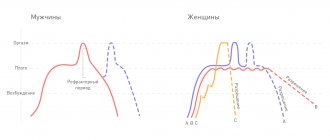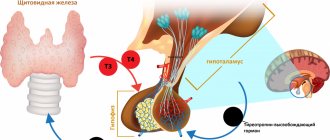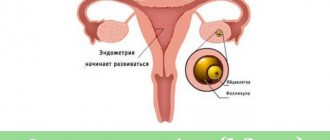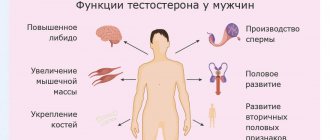Let's talk about female hormones, discuss the levels of hormones in the blood of women that affect sexual function.
The functioning of a woman’s reproductive system directly depends on the body’s production of hormones, some of which are produced directly by the gonads (ovaries) and adrenal glands, while others are produced in the part of the brain - the pituitary gland. It is hormones that influence how a woman’s menstrual cycle proceeds, whether she can become pregnant naturally, and whether she can bear a fetus.
What hormones affect reproductive function?
In order for a woman of reproductive age to have regular menstruation and for the egg to mature, so that she can conceive, carry and give birth to a child, and subsequently successfully feed him with breast milk, it is necessary that the body produces certain hormones in sufficient quantities. These hormones include:
- FSH or follicle stimulating hormone;
- LH (luteinizing hormone);
- prolactin;
- estradiol;
- anti-Mullerian hormone (AMH).
Thyroid condition
Thyroid-stimulating hormone (TSH)
- newborns 3-20 mIU/l
- adults 0.2-3.2 mIU/l
Total triiodothyronine (T3) 1.2-3.16 pmol/l
Total thyroxine (T4)
- newborns 100-250 nmol/l
- 1-5 years 94-194 nmol/l
- 6-10 years 83-172 nmol/l
- 11-60 years 60-155 nmol/l
- after 60 years men 60-129 nmol/l
- women 71-135 nmol/l
Free triiodothyronine (fT3) 4.4-9.3 pmol/l
Free thyroxine (fT4) 10-24 pmol/l
Thyroglobulin (TG) 0-50 ng/ml
Thyroxine-binding globulin (TBG) 13.6-27.2 mg/l during pregnancy over 5 months 56-102 mg/l
TSH-binding capacity 100-250 µg/l
Calcitonin 5.5-28 pmol/l
Hormones affecting the menstrual cycle
In order for a woman to continue her race, gonadotropic hormones are necessary. They are produced by cells of the anterior pituitary gland and include FSH, prolactin and luteinizing hormone.
FSH is responsible for the process of follicle growth in the ovary in women and sperm maturation in men. In the female body, follicle-stimulating hormone influences the conversion of testosterones into estrogens, the production of estrogens, and also the maturation of the egg.
Depending on the changes occurring in the female body, there are several phases of the menstrual cycle, during which the levels of sex hormones change:
- Follicular phase - its duration is individual for each woman, but on average it is 2 weeks (with a cycle duration of 28 days). During this phase, the follicle matures and the endometrial layer prepares to receive a fertilized egg.
- The ovulatory phase is characterized by the ripening and rupture of the dominant follicle, from which an egg ready for fertilization emerges. It moves through the fallopian tube and if a sperm is encountered on its way, fertilization occurs and pregnancy occurs. During the ovulatory phase, the level of FSH and luteinizing hormone in a woman’s body increases significantly. The duration of the ovulatory phase is approximately 5 days.
- Luteal phase - Graaffian vesicle turns into an endocrine gland for some time and progesterone or the so-called corpus luteum is intensively produced in the woman’s body. Progesterone is necessary for the successful attachment of the fertilized egg to the wall of the uterus if fertilization has occurred. If pregnancy does not occur, the level of progesterone and LH gradually decreases, which causes the development of changes in the vessels of the thickened endometrium, it is rejected and menstruation occurs.
Hormonal levels before pregnancy
Human vital activity is supported by more than 70 hormones that normalize various processes, activate the absorption of proteins, fats and carbohydrates, and destroy pathogenic substances. The lack of one or another hormone does not always immediately affect your well-being. Often a young woman does not notice health problems - her body is still full of strength, mild symptoms are ignored and attributed to PMS or fatigue. And only problems with conception or pregnancy reveal a serious hormonal imbalance.
Hormonal imbalance can cause miscarriage. Therefore, gynecologists advise undergoing an examination at the pregnancy planning stage and doing a hormone test before conception occurs. And not waste time for months looking at tests with one strip.
The level of hormones in the blood of women that affect sexual function
FSH and LH in a woman are measured in international units per liter (IU/L). In order for the analysis results to be reliable, it is necessary to donate blood from a vein on days 3-5 of the menstrual cycle, strictly on an empty stomach. The level of follicle-stimulating hormone constantly changes in different phases of the cycle and is:
- follicular phase – normal 2.8-11.2 mIU/l;
- ovulatory – 5.7-21 mIU/l;
- luteal – 1.2-9 U/l.
The correct ratio of the hormones FSH and LH is also very important; this is what determines a woman’s fertility, that is, her ability to conceive. To find out the ratio of FSH and LH, the amount of the second indicator is divided by the amount of the first. For example, in a girl before the onset of puberty, the ratio of FSH and LH is 1:1, after a year of regular menstruation the ratio increases to 1.5:1, and after another 2 years and until the onset of menopause, FSH is normally 2 times less, than LG. An upward change in the ratios in a woman of reproductive age indicates possible pathologies, including:
- pituitary tumor;
- polycystic ovary syndrome;
- premature depletion of ovarian reserve.
Luteinizing hormone (LH)
Luteinizing hormone in a woman’s body increases at the time of ovulation. The maximum increased amount of LH is observed from days 13 to 16 of the cycle (with a standard cycle of 28 days). In different phases of the menstrual cycle, the LH rate changes:
- follicular phase – normal range is from 2 to 14 mIU/l;
- ovulation phase – 24-150 mIU/l;
- luteal – 2-17 honey/l.
Prolactin
Prolactin is a hormone that is produced in the pituitary gland and stimulates lactation. In addition to its immediate significance, prolactin also increases with increased physical activity, sex, and orgasm and stress.
Normally, in the body of a woman of reproductive age, prolactin levels should not exceed 400-1000 mIU/l - in a woman who is not breastfeeding. An increase in the hormone above these levels can inhibit the growth of the follicle and the maturation of the egg, which will make pregnancy impossible even with regular menstruation. This is due to the fact that the cycle will be anovulatory.
Estradiol
Estradiol in the female body is formed in the ovaries and is produced in small quantities by the adrenal glands. In pregnant women, this hormone is also produced by the placenta. The process of estradiol production is completely dependent on the pituitary hormones - FSH and LH and begins to be produced from the first days of the menstrual cycle. By the middle of the cycle, the concentration of the hormone estradiol in the blood increases and 24 hours after the maximum concentration level is detected, ovulation occurs. After the dominant follicle bursts and a mature egg is released, estradiol levels gradually decrease. If the concentration of this hormone remains high even after expected ovulation, this means that the woman is pregnant. In a healthy woman, normal estradiol levels are as follows:
- follicular phase – 57-226 pg/ml;
- 24-36 hours before ovulation – 127-476 pg/ml;
- luteinizing – 77-226 pg/ml.
With age and the gradual depletion of the ovarian reserve of the ovaries, a woman’s fertility decreases, and the level of estradiol decreases accordingly, for example, during menopause, the hormone norm is 19-82 pg/ml.
Anti-Mullerian hormone (AMH)
AMH is a hormone that is produced in women by granulomatous cells of the ovaries from the moment of birth until the onset of menopause.
Anti-Mullerian hormone is an indicator of:
- ovarian reserve;
- indicates the aging process of the ovaries;
- indicates the chances of a woman becoming pregnant naturally or through an IVF procedure.
It is believed that the lower the concentration of AMH in a woman’s blood, the less chance she has of conceiving naturally. In girls before puberty, the AMH norm is from 1.0 to 3.5 ng/ml, in women of reproductive age from 1.0 to 5.3 ng/ml, with the onset of menopause these indicators decrease to almost zero.
| Hormone | Summary table of female hormone norms |
| FG | follicular phase – normal 2.8-11.2 mIU/l; |
| ovulatory – 5.7-21 mIU/l; | |
| luteal – 1.2-9 U/l. | |
| LH | follicular phase – normal range is from 2 to 14 mIU/l; |
| ovulation phase – 24-150 mIU/l; | |
| luteal – 2-17 honey/l. | |
| Prolactin | 400-1000 mIU/l |
| Estradiol | follicular phase – 57-226 pg/ml; |
| 24-36 hours before ovulation – 127-476 pg/ml; | |
| luteinizing – 77-226 pg/ml. | |
| AMG | girls before puberty, the AMH norm is from 1.0 to 3.5 ng/ml |
| in women of reproductive age from 1.0 to 5.3 ng/ml | |
| with the onset of menopause, these indicators drop to almost zero. |
Norms for hormone tests
Somatotropic function of the pituitary gland
Somatotropic hormone (GH) in blood serum
- newborns 10-40 ng/ml
- children 1-10 ng/ml
- adult men up to 2 ng/ml
- adult women up to 10 ng/ml
- men over 60 years old 0.4-10 ng/ml
- women over 60 years old 1-14 ng/ml
Somatotropic hormone (GH) in urine is determined in parallel with the determination of creatinine. It is enough to examine only the morning portion of urine:
- 1-8 years 10.2-30.1 ng per 1 g creatinine
- 9-18 years 9.3-29 ng per 1 g creatinine
Somatomedin in blood serum:
men
- 1-3 years 31-160 U/ml
- 3-7 years 16-288 U/ml
- 7-11 years 136-385 U/ml
- 11-12 years 136-440 U/ml
- 13-14 years 165-616 U/ml
- 15-18 years 134-836 U/ml
- 18-25 years 202-433 U/ml
- 26-85 years 135-449 U/ml
women
- 1-3 years 11-206 U/ml
- 3-7 years 70-316 U/ml
- 7-11 years 123-396 U/ml
- 11-12 years 191-462 U/ml
- 13-14 years 286-660 U/ml
- 15-18 years 152-660 U/ml
- 18-25 years 231-550 U/ml
- 26-85 years 135-449 U/ml
State of hormonal systems regulating sodium and water metabolism
Antidiuretic hormone - the norm depends on plasma osmolarity; this factor is taken into account when assessing the results
Blood ADH osmolarity
- 270-280 less than 1.5
- 280-285 less than 2.5
- 285-290 1-5
- 290-295 2-7
- 295-300 4-12
Renin
- when taking blood while lying down 2.1-4.3 ng/ml
- when drawing blood while standing 5.0-13.6 ng/ml
Angiotensin 1
- 11-88 pg/ml
Angiotensin 2
- in venous blood 6-27 pg/ml
- in arterial blood 12-36 pg/ml
Aldosterone
- in newborns 1060-5480 pmol/l (38-200 ng/dl)
- up to 6 months 500-4450 pmol/l (18-160 ng/dl)
- in adults 100-400 pmol/l (4-15 ng/dl)
Placental hormones
Beta human chorionic gonadotropin (beta-hCG, beta-hCG)
- in blood serum in adults up to 5 IU/l
- in the urine of pregnant women 6 weeks 13,000 IU/l
- 8 weeks 30,000 IU/l
- 12-14 weeks 105,000 IU/l
- 16 weeks 46,000 IU/l
- more than 16 weeks 5000-20 000 IU/l
Free estriol (E3)
in the blood of pregnant women
- 28-30 weeks 3.2-12.0 ng/ml
- 30-32 weeks 3.6-14.0 ng/ml
- 32-34 weeks 4.6-17.0 ng/ml
- 34-36 weeks 5.1-22.0 ng/ml
- 36-38 weeks 7.2-29.0 ng/ml
- 38-40 weeks 7.8-37.0 ng/ml
State of the hormonal calcium regulation system
Parathyroid hormone (PTH)
- 8-4 ng/l
Calcitriol
- 25-45 pg/ml (60-108 pmol/l)
Osteocalcin
- children 39.1-90.3 ng/ml
- women 10.7-32.3 ng/ml
- men 14.9-35.3 ng/ml
Total hydroxyproline in urine
- 1-5 years 20-65 mg/day or 0.15-0.49 mmol/day
- 6-10 years 35-99 mg/day or 0.27-0.75 mmol/day
- 11-14 years 63-180 mg/day or 0.48-1.37 mmol/day
- 18-21 years 20-55 mg/day or 0.15-0.42 mmol/day
- 22-40 years 15-42 mg/day or 0.11-0.32 mmol/day
- 41 and older 15-43 mg/day or 0.11-0.33 mmol/day
Pancreatic function
- Insulin 3-17 µU/ml
- Proinsulin 1-94 pmol/l
- C-peptide 0.5-3.0 ng/ml
- Glucagon 60-200 pg/ml
- Somatostatin 10-25 ng/l
Pancreatic peptide (PP)
- 20-29 years 11.9-13.9 pmol/l
- 30-39 years 24.5-30.3 pmol/l
- 40-49 years 36.2-42.4 pmol/l
- 50-59 years 36.4-49.8 pmol/l
- 60-69 years 42.6-56.0 pmol/l
Pituitary hormones
TSH (thyroid stimulating hormone)
– stimulates the production of thyroid hormones (T3 and T4). Normal values: 0.4-4.0 mU/l. An elevated TSH value usually indicates decreased thyroid function.
FSH (follicle stimulating hormone)
. Normal values: in women - depends on the phase of the menstrual cycle. Phase I – 3.35-21.63 mU/ml; Phase II – 1.11-13.99 mU/ml; postmenopause – 2.58-150.53 mU/ml; girls under 9 years old 0.2-4.2 mU/ml. In men – 1.37-13.58 mU/ml.
LH (luteinizing hormone)
. Normal values: in women - depends on the phase of the menstrual cycle. Phase I – 2.57-26.53 mU/ml; Phase II – 0.67-23.57 mU/ml; postmenopause – 11.3-40 mU/ml; girls under 9 years old - 0.03-3.9 mU/ml. In men – 1.26-10.05 mU/ml.
Prolactin
. The main function is to stimulate the development of mammary glands and lactation. Normal values: in women (from the first menstruation to menopause) – 1.2-29.93 ng/ml; in men – 2.58-18.12 ng/ml. An increased concentration of prolactin in women leads to menstrual irregularities and may cause infertility. In men, hyperprolactinemia leads to decreased libido and impotence.
ACTH
(adrenocorticotropic hormone) - stimulates the synthesis and secretion of hormones from the adrenal cortex. Normal values: 9-52 pg/ml.
Prenatal (prenatal) diagnosis of congenital and hereditary diseases
Alpha fetoprotein (AFP)
gestational age:
- 13-14 weeks 20.0 IU/ml
- 15-16 weeks 30.8 IU/ml
- 17-18 weeks 39.4 IU/ml
- 19-20 weeks 51.0 IU/ml
- 21-22 weeks 66.7 IU/ml
- 23-24 weeks 90.4 IU/ml
Free human chorionic gonadotropin (hCG, hCG)
gestational age:
- 13-14 weeks 67.2 IU/ml
- 15-16 weeks 30.0 IU/ml
- 17-18 weeks 25.6 IU/ml
- 19-20 weeks 19.7 IU/ml
- 21-22 weeks 18.8 IU/ml
- 23-24 weeks 17.4 IU/ml








